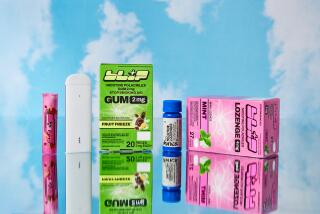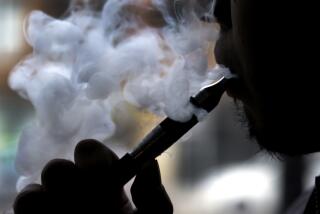The Mystery of Philip Morris’ Nicotine Inhaler
Cigarette maker Philip Morris has developed an inhaler that could deliver a nicotine mist deep into the lungs, giving smokers a satisfying dose of the addictive drug without the carcinogens, gases and toxic metals that make tobacco smoke so dangerous.
Cloaked in secrecy, the device was invented nearly a dozen years ago at a time the tobacco industry was vigorously denying that nicotine was addictive, internal company documents show. It was part of an effort by the top cigarette maker to explore the possibility of offering a “clean” form of nicotine to those who can’t or won’t quit.
A nicotine inhaler probably would draw a mixed response, similar to the debate over offering clean needles to heroin users. Though some health professionals might object to any product that sustains nicotine dependence, many others say “clean” nicotine could be a powerful weapon in the fight against tobacco-related diseases.
For reasons Philip Morris declines to discuss, the project appears to have stalled. The company has been aggressively courting pharmaceutical companies to use the inhaler for therapeutic drugs, but its future as a cigarette alternative is a mystery.
“For competitive reasons, we do not comment on our future business plans,” said Peggy Roberts, senior director of communications for Philip Morris USA, which is part of Altria Group Inc.
For Philip Morris, a nicotine inhaler would pose clear risks.
The company controls 50% of the U.S. cigarette market on the strength of its Marlboro brand, the world’s most popular cigarette. An alternative product, if successful, could cannibalize Philip Morris’ existing business -- and possibly create a new public relations headache. Mitch Zeller, a former Food and Drug Administration official, said some might accuse the company “of getting smokers at both ends” and “keeping the customer in the franchise in a very clever way.”
Unlike cigarettes, which are not regulated by the Food and Drug Administration, a tobacco-free nicotine product would face a long and costly government review, with uncertain results.
Yet, as it strives to improve its tattered image, Philip Morris could benefit by appearing to be part of the solution, some observers said.
“The cigarette manufacturers don’t want to kill their customers,” said Kenneth Warner, dean of the University of Michigan School of Public Health. “That’s simply an unfortunate side effect of use of the product.”
“If they can come up with a substitute that would capture the same-size market, they’d love it,” Warner said. It would “save them a lot of legal fees” and “they’d feel more virtuous.”
Since admitting the dangers of smoking a few years ago, Philip Morris has publicly pledged to lower the risks.
As Michael Szymanczyk, the company’s chief executive, told a group of financial analysts in 2002, “Our scientists are working with a single-minded focus on finding ways to reduce a smoker’s exposure to potentially harmful constituents in tobacco smoke.”
Yet the company and its rivals often have been accused of holding back safety advances to avoid undermining their existing products. It’s a charge echoed by the Justice Department in its racketeering case against the tobacco industry in Washington.
Tobacco companies have denied the claim, citing major investments in potentially less risky products such as Philip Morris’ Accord and R.J. Reynolds’ Eclipse, both designed to heat, rather than burn, tobacco.
But William A. Farone, former director of applied research at Philip Morris, said the company had a long history of exploring promising developments such as the nicotine inhaler -- then getting cold feet. “They always worried in the ultimate about losing the damn gold mine they have,” said Farone, who was fired in 1984 for what the company said was insubordination.
Now, Chrysalis Technologies Inc., a tiny Philip Morris subsidiary, is trying to sell the inhaler as an alternative to injections for a variety of medications, including pain remedies and treatments for emphysema, a disease caused by smoking.
Last January, for example, Chrysalis touted the hand-held device, called Aria, at a drug-delivery conference in San Diego. Brooks Adams, director of business development for Chrysalis, described it as a “compact, easy-to-use portable inhaler” with “high lung-dosing potential,” according to a copy of his presentation.
Nicotine is a mild stimulant that helps some people to focus and relax when under stress. Although a crucial part of a deadly product, nicotine by itself is not very bad for most people, experts say.
It does increase the heart rate and could harm people with an existing cardiac condition. For others, however, the effect is similar to mild exercise, said Dr. Neal Benowitz, a nicotine expert and professor of medicine, psychiatry and biopharmaceutical sciences at UC San Francisco.
Existing nicotine replacement products -- patches, gum and inhalers sold to help smokers quit -- are designed not to be addictive. They do not deliver the same satisfying dose of nicotine as cigarettes, and many who try them relapse into smoking. But if the most stubbornly addicted were to trade cigarettes for regular use of a nicotine inhaler, “the health benefits would be enormous,” Benowitz said.
Writing in the journal Tobacco Control in 2003, Walton Sumner, an associate professor of medicine at Washington University in St. Louis, said “clean nicotine inhalers might improve public health as much as any feasible tobacco control effort.”
Some in the tobacco industry have long shared that opinion. In a memo written in 1972, R.J. Reynolds scientist Claude E. Teague Jr. posed this question:
“If our business is fundamentally that of supplying nicotine ... why is it really necessary that allegedly harmful ‘tar’ accompany that nicotine?
“There should be some simpler, ‘cleaner,’ more efficient and direct way to provide the desired nicotine dosage ... free of allegedly harmful combustion products.”
By the time Farone left Philip Morris in 1984, the company was already investigating new ideas for delivering nicotine, the former director of applied research said. He recalled an experiment in which company scientists mixed a solution of nicotine, water and propylene glycol, put it in a pressurized sprayer, and gave it to him to try.
Internal documents show that research over the next several years led to the invention in January 1994 of the “capillary aerosol generator,” the inhaler’s technical name.
The documents are available under terms of the 1998 legal settlements between state attorneys general and the tobacco industry. Cigarette makers agreed to make internal records public, and they now appear on websites such as www.legacy.library.ucsf.edu at UC San Francisco. References to the device appear in numerous memos, minutes and briefings spanning a decade.
The invention was the most ambitious piece of what Philip Morris dubbed its “Ideal Smoke” program, an effort to develop less toxic, commercially viable products. The Accord device, which delivers about as much tar as an ultra-low-tar cigarette, is an “Ideal Smoke” concept; it is being test-marketed in Richmond, Va., and Japan.
According to a 1991 company document, an ideal inhaler would be designed to deliver a “controllable and sufficient nicotine concentration.” A 1992 document cites research to determine the amount of nicotine solution needed in the inhaler “to give a nicotine response relative to specific cigarette deliveries.”
Another memo that year reflects the thinking behind the work. “The primary reason” people smoke “is to deliver nicotine into their bodies,” the memo says. New forms of nicotine could “replace or transform the worldwide cigarette business as we know it.”
The inhaler had to be capable of producing minute particles of nicotine the way a cigarette does. Success was finally achieved “in producing aerosols similar to tobacco smoke,” another memo says. “Particularly exciting is the very small aerosol particle size and the higher efficiency for delivery ... to the deep lung.”
In a second phase of work, dubbed Project Leap, scientists and executives began to study the suitability of the inhaler as a consumer product. “Attributes: does not contain tobacco” but “delivers nicotine,” a May 1994 document says.
Smoking involves the rituals of lighting up and inhaling and exhaling smoke, and it’s unclear whether research had progressed to the point of gauging the willingness of smokers to give up those routines.
But the project collided with an unprecedented wave of legal attacks in 1994 -- all based on claims that tobacco companies consciously had sought to addict consumers. In response, Philip Morris publicly denied what documents showed was a basic premise of Project Leap: that nicotine was addictive and the main reason people smoked.
First, the FDA stunned the industry in February 1994, declaring its intent to regulate tobacco products as drug delivery devices. (The effort failed when the industry took a successful challenge to the Supreme Court.)
March brought the filing of the Castano case -- a nationwide class-action suit on behalf of allegedly addicted smokers.
And in April tobacco chief executives, including Philip Morris’ president at the time, William Campbell, testified under oath before Congress that nicotine wasn’t addictive.
Research on the inhaler shows that inside Philip Morris, “it was a given that nicotine was addictive,” said Mitch Zeller, the FDA’s director of tobacco programs at the time the agency launched its attack. Had word of the research leaked out, “it would have exposed the hypocrisy of all of their public statements at the time about nicotine,” Zeller said.
Whether to avoid that risk or for some other reason, documents suggest the company’s focus changed. A December 1994 memo describes plans to fund research at Virginia Commonwealth University on using the device “for applications in the pharmaceutical industry.”
That research is continuing at Virginia Commonwealth, which, like Philip Morris, is based in Richmond. According to the university’s figures, Chrysalis since 2000 has given $11 million to a team headed by Peter R. Byron, an aerosol expert who is chairman of the school’s department of pharmaceutics. Byron said that he could not discuss details of the work but that it did not involve nicotine.
Even so, a company document from 2001 shows the original idea was still alive.
It’s a list of research plans, including a study on whether the inhaler “can be developed into a reduced-harm product.”
More to Read
Inside the business of entertainment
The Wide Shot brings you news, analysis and insights on everything from streaming wars to production — and what it all means for the future.
You may occasionally receive promotional content from the Los Angeles Times.










